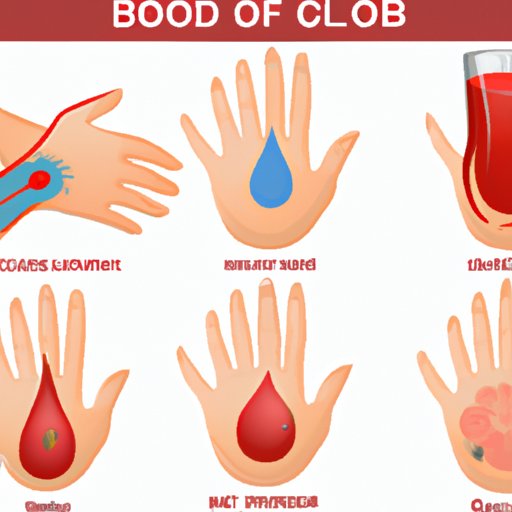
I. Introduction
A blood clot, or thrombus, forms when blood thickens and clumps together, blocking the flow of blood through veins or arteries. If left untreated, blood clots can be life-threatening. Therefore, it’s essential to know the symptoms of a blood clot and seek medical attention promptly when experiencing them. This article will explore the symptoms, risk factors, diagnosis, prevention, and treatment of blood clots.
II. Symptoms of a Blood Clot
The symptoms of a blood clot depend on its location. Some common symptoms include:
A. Swelling
Swelling is a common symptom of deep vein thrombosis (DVT), which occurs when a blood clot forms in a deep vein, usually in the leg. The affected limb may feel heavy and achy, and the swelling may be accompanied by pain and warmth.
B. Tenderness
The affected area may be tender when touched, and the skin may feel tight or stretched. This symptom usually accompanies swelling.
C. Pain
Pain is another common symptom of DVT. The pain may be concentrated in the affected area or may radiate to the surrounding areas.
D. Warmth
The affected limb may feel warm to the touch, and the skin may be red or discolored. This symptom is also common in DVT cases.
E. Skin Discoloration
In cases of DVT, the skin on the affected limb may take on a bluish or reddish tint due to poor circulation.
III. Risk Factors and Causes of Blood Clots
Several factors can increase the risk of blood clots, including:
A. Obesity
Being overweight or obese makes it more difficult for blood to circulate properly through the body, increasing the risk of blood clots. Moreover, excess fat tissue releases substances that contribute to inflammation, increasing the risk further.
B. Smoking
Smoking damages blood vessels and increases the risk of blood clots by making the blood more prone to clotting.
C. Prolonged Periods of Inactivity
Staying in one position for prolonged periods, such as during long-haul flights or bed rest after an injury or surgery, increases the risk of blood clots by slowing down blood circulation in the body.
D. Different Types of Blood Clots
There are different types of blood clots, each with varying risk factors. For example, atrial fibrillation, a type of irregular heartbeat, is a common risk factor for stroke-causing blood clots. Hormone therapy and pregnancy increase the risk of blood clots in women, especially in the legs or lungs.
E. Triggers of Blood Clot Formation
There are several triggers that can increase the risk of blood clots, including surgery, trauma, cancer, and certain medications.
IV. Diagnosis of Blood Clots
Your doctor may perform several tests to diagnose a blood clot, including:
A. Medical History and Physical Exam
Your doctor will ask about your symptoms, medical history, and family history of blood clots. They will also perform a physical exam to check for any signs of a blood clot.
B. Blood Tests
A blood test may be performed to check for any abnormalities that may indicate a blood clot, such as an increase in D-dimer or clotting factors.
C. Imaging Tests
Several imaging tests can help diagnose blood clots, including ultrasound, CT scan, MRI, and venogram. Your doctor will determine the appropriate test based on your symptoms and medical history.
V. Prevention of Blood Clots
Several lifestyle changes can help prevent blood clots, including:
A. Regular Exercise
Regular exercise can help improve blood circulation in the body and reduce the risk of blood clots. Doctors usually recommend 30 minutes of moderate exercise every day.
B. Healthy Diet
Eating a diet low in saturated fats and high in fiber can help maintain a healthy weight, reducing the risk of obesity and blood clots.
C. Treatment of Underlying Health Conditions
Managing underlying health conditions, such as hypertension, high cholesterol, and diabetes, can reduce the risk of blood clots.
VI. Treatment of Blood Clots
The treatment of blood clots depends on the location and severity of the clot. Some commonly used treatments include:
A. Blood Thinners
Anticoagulants or blood thinners are commonly prescribed to prevent the growth and formation of blood clots. They work by reducing the blood’s ability to clot and prevent existing clots from getting bigger.
B. Catheter-directed Thrombolysis
This procedure involves inserting a thin catheter into the affected vein, and a medication is injected to dissolve the clot. This is a minimally invasive procedure that may be used for severe cases of DVT or pulmonary embolism.
C. Surgery
In severe cases, surgery may be necessary to remove the clot, especially when it’s causing life-threatening complications.
D. Vena Cava Filter
A vena cava filter may be inserted into the inferior vena cava, a large vein that carries blood from the lower body back to the heart, to prevent blood clots from traveling to the lungs.
VII. When to See a Doctor
If you experience any of the symptoms of a blood clot, such as swelling, tenderness, pain, warmth, or skin discoloration, you should seek medical attention promptly. Neglecting symptoms can result in severe complications, including stroke, heart attack, or pulmonary embolism.
A. Importance of Prompt Medical Attention
Timely diagnosis and treatment of a blood clot can help prevent severe complications and increase the chances of a full recovery.
B. Possible Consequences of Neglecting Symptoms
Neglecting symptoms can result in severe complications, including stroke, heart attack, or pulmonary embolism.
C. Examples of Symptoms That Require Immediate Medical Attention
Symptoms that require immediate medical attention include sudden chest pain, shortness of breath, sudden numbness or weakness, and sudden and severe headache.
VIII. Conclusion
Knowing the symptoms of a blood clot, risk factors, and prevention strategies is essential for maintaining good health and preventing life-threatening complications. If you experience any symptoms of a blood clot, you should seek medical attention immediately. Remember, early diagnosis and treatment can save your life.
Stay healthy by maintaining an active lifestyle, eating a balanced diet, and managing underlying health conditions.
And, always remember to speak to a healthcare provider if anything seems off-kilter.





